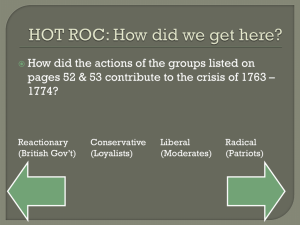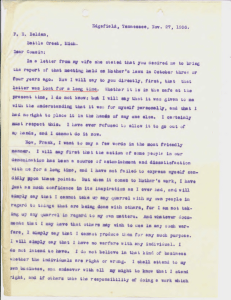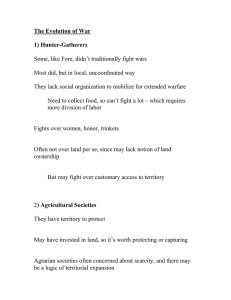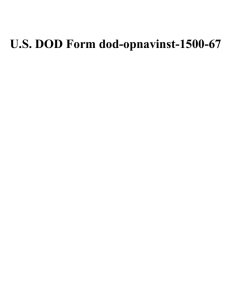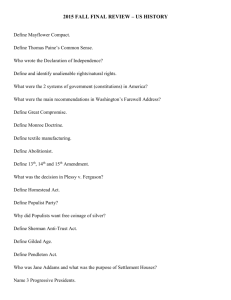U.S. DOD Form dod-opnavinst-3501-4a
advertisement
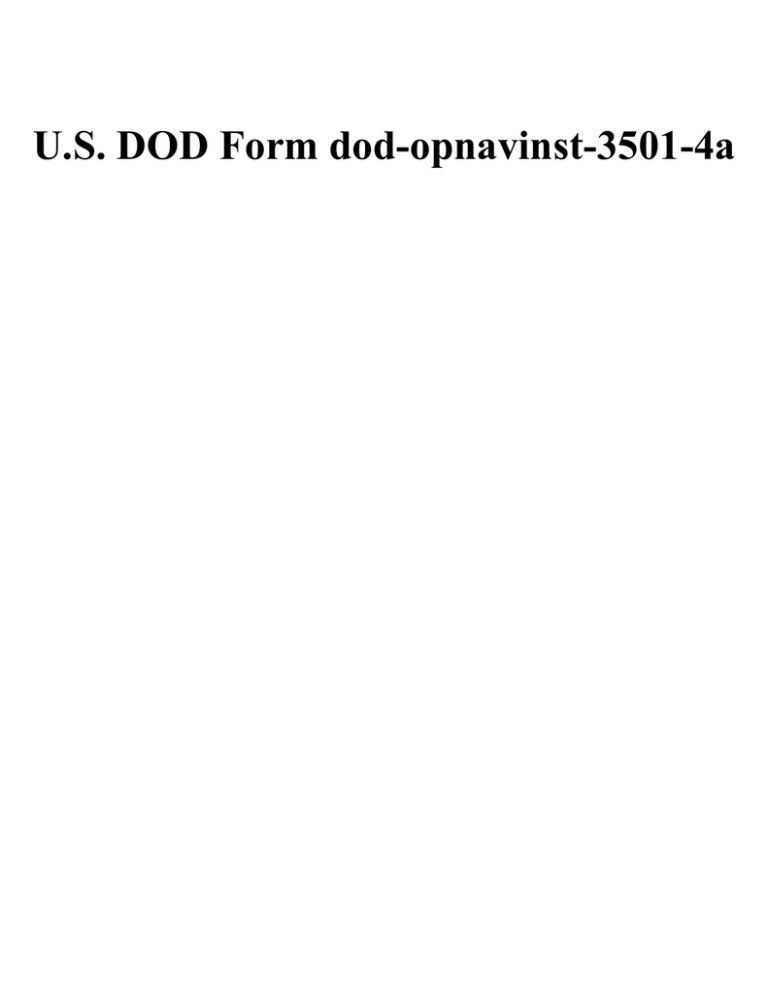
U.S. DOD Form dod-opnavinst-3501-4a DEPARTMENT OFFICE OF THE CHIEF WASHINGTON, OF THE NAVY OF NAVAL OPERATI DC 20350-2000 0 NS IN RE PLY REFER TO OPNAVINST 3 502.4A OP-39 2 June 1992 OPNAV INSTRUCTION 3502.4A From: Chief Subj : SURFACE Ref: (a) OPNAVINST 1500.51B Total Force Training Strategy (b) OPNAVINST 1500.57 Surface Warfare Training Strategy (c) OpNAVINST 1500.52 Surface Warfare Training System Policy, Organization and Responsibilities (d) OPNAVINST 1543.49B Technical Training Equipment (TTE) Acquisition and Management (e) opNAVINST 1500.59 Surface Warfare Training System Acquisition Process and Responsibilities (f) OPNAVINST 5000.49A” Integrated Logistic Support in the Acquisition Process (g) OPNAVINST 5000.50A Navy Training Simulator and Device Acquisition and Management Encl : (1) Surface Warfare Training Review Board (SWTRB) Guidelines (2) Conventional Marine Propulsion Training Steering Committee (CMPTSC) Guidelines (3) Combat Systems Manpower and Training Steering Committee (CSMTSC) Guidelines (4) SWTRB, CMPTSC, CSMTSC and Working Groups Membership Matrices (5) Organizational Diagram (6) Standard Requirements Summary Paper for Technical Training Equipment, Trainers, Training Devices, and Training Aids of Naval WARFARE Operations TRAINING REVIEW BOARDS AND COMMITTEES 1. Purpose. To establish organization, guidance and procedures for assemblies of command representatives convened to assess training requirements (less nuclear propulsion) and to provide both short and long–term guidance in planning and managing Surface Warfare training. This instruction incorporates major revisions and shall be read in its entirety. 2. . — Cancellation. OPNAVINSTS 3502.3, 3502.4 and 5420.96. IllI1111 IIllltlll III1111 1111111 Illlnll 1111 II OPNAVINST 3502.4A 2 JUN 1992 3. Discussion a. Navy Total Force Training Strategy, addressed in reference (a), states broad policy, defines and describes specific responsibilities and provides procedural guidance for all Navy Training. Reference (b) refines and expands the principles of reference (a) by stating definite means by which Surface Warfare training will be developed and managed. Further policy guidance, organization and procedures for the administration, execution and operation of Surface Warfare training processes are found in references (c) through (f). b. This revised instruction incorporates elements of Total Quality Leadership (TQL) to improve the Surface Warfare training process at all levels. Doing so provides: (1) teamwork across functional groups; (2) two-way communications throughout the training organization; (3) constancy of purpose for the improvement of the process; (4) continual improvements to the process; (5) emphasis of training at every level of the Surface Warfare organization and (6) a structured approach to identifying and solving problems. 4. Structure of Standing Committees. committees are~rganized Surface Warfare training as follows: a. Surface Warfare Traininq Review Board (SWTRB). A Captain (0–6)/GM–15 level steering committee, chaired by the Director, Surface Warfare Manpower and Training Requirements Division (OP–39), which assesses existing training and training plans, and provides recommendations to the Deputy Assistant Chief of Naval Operations (Surface Warfare) (oP–OSB), to improve Surface Warfare training effectiveness. This board shall direct the efforts of the subordinate steering committees. Enclosure (1) sets forth guidance for the SWTRB, whose organization is shown in enclosures (4) and (5). b. Conventional Marine Propulsion Training Steering Committee chaired by the Director, (CMPTSC). A Captain level committee, Surface Warfare Manpower and Training Requirements Division (OP-39), which represents the Chief of Naval Operations (OPNAV) staff, fleet and training commands. It is established to search out and recommend solutions to fleet engineering shortcomings which can be most effectively and efficiently achieved through training. Enclosure (2) sets forth the operating guidance and membership of the CMPTSC. Organizational structure of the CMPTSC working group and relationships are shown in enclosures (4) 2 OPNAVINST 3502.4A # JUN IW2 and (5). SWTRB . The CMPTSC reports to, and receives guidance from, the Combat Systems Manpower and Training Steering Committee chaired by the Director, This Captain level committee, (Csmkc). Surface-Warfare Manpower and Training Requirements Division (oP–39), is established to provide a focal point from which to provide long term coordinated planning and guidance for Surface Warfare platform–level combat system manning and training Enclosure (3) sets forth the operating guidance and requirements. The organizational structure of the composition of the CSMTSC. CSMTSC working groups and relationships are shown in enclosures from, The CSMTSC reports to, and receives guidance (4) and (5). the SWTRB. -— Training Technoloq Y work-? d. EzQ!?I?” This special working group has been established to support the SWTRB, CMPTSC and the and Training (CNET) is assigned CSMTSC . Chief of Naval Education In short, the group as the permanent chair of the working group. shall investigate and brief both new and future training technology developments on an “as required” basis as requested bY CNET the SWTRB or either of the two steering committees. directives provide specific details concerning the charter? relationships and goals of the working group separately mission, The working group’s relationship is shown from this instruction. in enclosure (5). Surface Warfare Training Advisory Board. This contingency e. Chief of Naval steering group, within the office of the Assistant Surface Warfare (OP–03) is convened as required. Operations, is enhanced training effectiveness through SWTAB’S objective and management of Surface warfare improved coordination, planning, It may be achieved by recommending training Training resources. policy and initial management directives, controls, analysis, and monitoring procedures which will attain and evaluation, maintain the highest degree of personnel readiness, within throughout the life cycle of a ship available program resources, Membership shall consist of OP-03B (Chair), all class or system. OP–03 Division Directors and respective OP–03 branch heads, as a particular ship class, required, for issues concerning The individual system, or other training issues as warranted. SWTAB relationship in the Surface Warfare Training organization is seen in enclosure (5). 3 OPNAVINST 3502.4A 2 JUN 1992 — 5. Responsibilities. and staffs are defined Responsibilities of commands, activities in enclosures (1) through (3). have been reviewed by fleet and 6. Review. Drafts of instruction as well as SWTRB charter members in the Surface type commanders, All feedback has been evaluated and Navy training community. Future reviews will incorporated into this instruction as needed” be initiated by OP–392 every two years. The reports required Reports. 7. from reports control by SECNAVINST Deputy by this instruction 5214.2B. P. M. Quast Assistant Chief of Naval (Surface Warfare) are exempt Operations Distribution: SNDL 21A 23B2 24D 24H 25A 26B3 26KKK 28C1 C84P FF5 FKAIG FKPIG FKP20 FKR31 FT1 FT5 FT22 FT24 FT30 FT31 FT35 FT39 FT43 FT46 (FLEET COMMANDERS IN CHIEF) (SPECIAL FORCE COMMANDER PAC) (COMNAVSPECWARCOM only) (SURFACE FORCE COMMANDERS) (FLEET TRAINING COMMANDS) (COMINEWARCOM only) (COMNAVSURFRESFOR) (TACTRAGRU) (SURFACE GROUP LANT) (COMSURFWARDEVGRU only) (NUSC DET) (NEW LONDON CT (Code 3123 only)) (NAVSAFECEN) (COMNAVSEASYSCOM) (sEA-04MP2, 06K2, PMS-300, 303, 377, 383, 407,) (NAVSHIPWPNSYSENGSTA) (AEGISTRACEN) (NAVTRASYSCEN) (Codes 00, N-33? PDA) (cNET) (5) (CNTECHTRA) (3) (FCTC) (FLETRACEN) (SERVSCOLCOM) (NTC) (Philadelphia PA onlY) (NAVPHIBSCOL ) (NAVTECHTRACEN ) (SWOSCOLCOM) (FLEASWTRACEN ) 4 —



